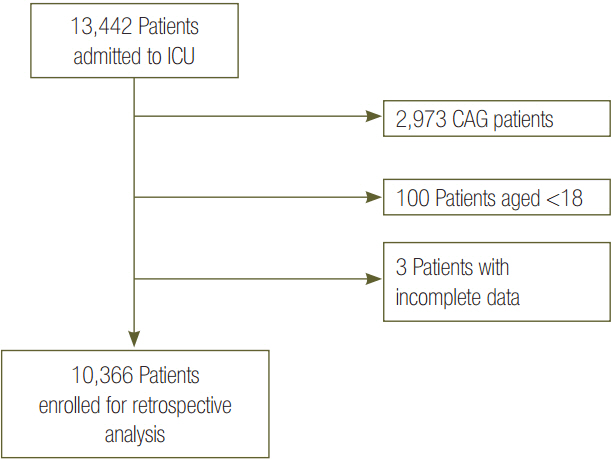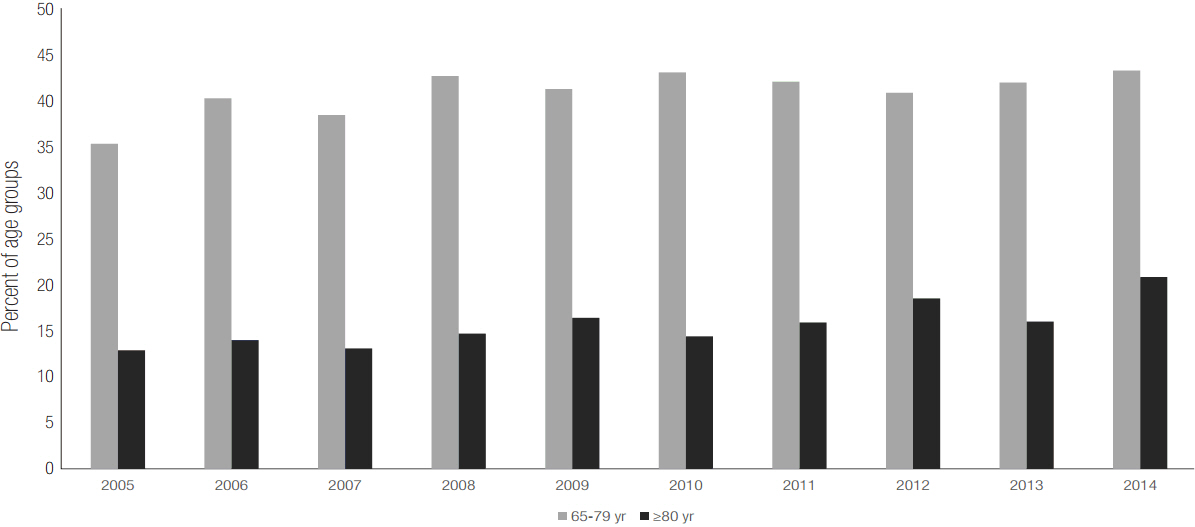Korean J Crit Care Med.
2017 May;32(2):164-173. 10.4266/kjccm.2016.00668.
Demographic Changes in Intensive Care Units in Korea over the Last Decade and Outcomes of Elderly Patients: A Single-Center Retrospective Study
- Affiliations
-
- 1Division of Pulmonary, Critical Care and Sleep Medicine, Department of Internal Medicine, St. Paul's Hospital, College of Medicine, The Catholic University of Korea, Seoul, Korea. agmante@gmail.com
- KMID: 2384041
- DOI: http://doi.org/10.4266/kjccm.2016.00668
Abstract
- BACKGROUND
Aging is a significant issue worldwide, and Korea is one of the most rapidly aging countries. Along with the demographic transition, the age structure of intensive care unit (ICU) patients changes as well.
METHODS
The aim of this study was to analyze the change in age distribution of the ICU patients over the last 10 years and its effect on clinical outcomes. Single-center, retrospective analysis of all patients aged ≥18 years admitted to either the medical or surgical ICU at St. Paul's Hospital, The Catholic University of Korea, between January 2005 and December 2014 was conducted. For clinical outcome, in-hospital mortality, duration of ICU stay, and hospital stay were analyzed. Cost analysis was performed to show the economic burden of each age strata.
RESULTS
A total of 10,366 ICU patients were admitted to the chosen ICUs during the study period. The proportion of elderly patients aged ≥65 years increased from 47.9% in 2005 to 63.7% in 2014, and the proportion of the very elderly patients aged ≥80 years increased from 12.8% to 20.7%. However, this increased proportion of elderly patients did not lead to increased in-hospital mortality. The percent of ICU treatment days attributable to elderly patients increased from 51.1% in year 2005 to 64.0% in 2014. The elderly ICU patients were associated with higher in-hospital mortality compared to younger age groups.
CONCLUSIONS
The proportion of elderly patients admitted to ICUs increased over the last decade. However, overall in-hospital mortality has not increased during the same period.
Keyword
MeSH Terms
Figure
Cited by 2 articles
-
Should Very Old Patients Be Admitted to the Intensive Care Units?
Jun Kwon Cha, In-Ae Song
Korean J Crit Care Med. 2017;32(4):376-377. doi: 10.4266/kjccm.2017.00521.Characteristics and prognostic factors of very elderly patients admitted to the intensive care unit
Song-I Lee, Younsuck Koh, Jin Won Huh, Sang-Bum Hong, Chae-Man Lim
Acute Crit Care. 2022;37(3):372-381. doi: 10.4266/acc.2022.00066.
Reference
-
References
1. United Nations. World population prospects: the 2006 revision [Internet]. New York (NY): United Nations;2007. [cited 2017 May 22]. Available from https://www.un.org/esa/population/publications/wpp2006/wpp2006.htm.2. United Nations. Department of Economic and Social Affairs, Population Division. World mortality 2007 [Internet]. New York (NY): United Nations;2007. [cited 2017 May 18]. Available from: http://www.unpopulation.org.3. Statistics Korea. The distribution of the population according to age and medical expenditures by age groups [Internet]. Daejeon: Statistics Korea;[cited 2017 May 22]. Available from: http://kostat.go.kr/portal/korea/index.action.4. Boumendil A, Guidet B. Elderly patients and intensive care medicine. Intensive Care Med. 2006; 32:965–7.
Article5. Song X, MacKnight C, Latta R, Mitnitski AB, Rockwood K. Frailty and survival of rural and urban seniors: results from the Canadian study of health and aging. Aging Clin Exp Res. 2007; 19:145–53.
Article6. Kaarlola A, Tallgren M, Pettila V. Long-term survival, quality of life, and quality-adjusted life-years among critically ill elderly patients. Crit Care Med. 2006; 34:2120–6.
Article7. Somme D, Maillet JM, Gisselbrecht M, Novara A, Ract C, Fagon JY. Critically ill old and the oldest old patients in intensive care: short- and long-term outcomes. Intensive Care Med. 2003; 29:2137–43.8. Boumendil A, Aegerter P, Guidet B; CUB-Rea Network. Treatment intensity and outcome of patients aged 80 and older in intensive care units: a multicenter matched-cohort study. J Am Geriatr Soc. 2005; 53:88–93.
Article9. Bagshaw SM, Webb SA, Delaney A, George C, Pilcher D, Hart GK, et al. Very old patients admitted to intensive care in Australia and New Zealand: a multi-centre cohort analysis. Crit Care. 2009; 13:R45.
Article10. Reinikainen M, Uusaro A, Niskanen M, Ruokonen E. Intensive care of the elderly in Finland. Acta Anaesthesiol Scand. 2007; 51:522–9.
Article11. Knaus WA, Draper EA, Wagner DP, Zimmerman JE. APACHE II: a severity of disease classification system. Crit Care Med. 1985; 13:818–29.12. Knaus WA, Wagner DP, Draper EA, Zimmerman JE, Bergner M, Bastos PG, et al. The APACHE III prognostic system: risk prediction of hospital mortality for critically ill hospitalized adults. Chest. 1991; 100:1619–36.13. Moreno RP, Metnitz PG, Almeida E, Jordan B, Bauer P, Campos RA, et al. SAPS 3--from evaluation of the patient to evaluation of the intensive care unit. Part 2: development of a prognostic model for hospital mortality at ICU admission. Intensive Care Med. 2005; 31:1345–55.14. Le Gall JR, Lemeshow S, Saulnier F. A new Simplified Acute Physiology Score (SAPS II) based on a European/North American multicenter study. JAMA. 1993; 270:2957–63.
Article15. Adhikari NK, Fowler RA, Bhagwanjee S, Rubenfeld GD. Critical care and the global burden of critical illness in adults. Lancet. 2010; 376:1339–46.
Article16. Teno JM, Gozalo PL, Bynum JP, Leland NE, Miller SC, Morden NE, et al. Change in end-of-life care for Medicare beneficiaries: site of death, place of care, and health care transitions in 2000, 2005, and 2009. JAMA. 2013; 309:470–7.17. Conti M, Merlani P, Ricou B. Prognosis and quality of life of elderly patients after intensive care. Swiss Med Wkly. 2012; 142:w13671.
Article18. Hennessy D, Juzwishin K, Yergens D, Noseworthy T, Doig C. Outcomes of elderly survivors of intensive care: a review of the literature. Chest. 2005; 127:1764–74.19. Haas LE, Karakus A, Holman R, Cihangir S, Reidinga AC, de Keizer NF. Trends in hospital and intensive care admissions in the Netherlands attributable to the very elderly in an ageing population. Crit Care. 2015; 19:353.
Article20. Kawakami T, Mizoguchi M, Saito R, Soma Y. Histopathological evidence of small-vessel vasculitis within the skin and lungs associated with interstitial pneumonia in an adult patient with dermatomyositis. Clin Exp Dermatol. 2008; 33:415–7.
Article21. Al-Dorzi HM, Tamim HM, Mundekkadan S, Sohail MR, Arabi YM. Characteristics, management and outcomes of critically ill patients who are 80 years and older: a retrospective comparative cohort study. BMC Anesthesiol. 2014; 14:126.
Article22. Pavoni V, Gianesello L, Paparella L, Buoninsegni LT, Mori E, Gori G. Outcome and quality of life of elderly critically ill patients: an Italian prospective observational study. Arch Gerontol Geriatr. 2012; 54:e193–8.
Article23. Fuchs L, Chronaki CE, Park S, Novack V, Baumfeld Y, Scott D, et al. ICU admission characteristics and mortality rates among elderly and very elderly patients. Intensive Care Med. 2012; 38:1654–61.
Article24. Baldo V, Cocchio S, Baldovin T, Buja A, Furlan P, Bertoncello C, et al. A population-based study on the impact of hospitalization for pneumonia in different age groups. BMC Infect Dis. 2014; 14:485.
Article25. Lerolle N, Trinquart L, Bornstain C, Tadie JM, Imbert A, Diehl JL, et al. Increased intensity of treatment and decreased mortality in elderly patients in an intensive care unit over a decade. Crit Care Med. 2010; 38:59–64.
Article26. Sznajder M, Leleu G, Buonamico G, Auvert B, Aegerter P, Merliere Y, et al. Estimation of direct cost and resource allocation in intensive care: correlation with Omega system. Intensive Care Med. 1998; 24:582–9.
Article27. Friedrich JO, Wilson G, Chant C. Long-term outcomes and clinical predictors of hospital mortality in very long stay intensive care unit patients: a cohort study. Crit Care. 2006; 10:R59.28. Torres OH, Francia E, Longobardi V, Gich I, Benito S, Ruiz D. Short- and long-term outcomes of older patients in intermediate care units. Intensive Care Med. 2006; 32:1052–9.
Article
- Full Text Links
- Actions
-
Cited
- CITED
-
- Close
- Share
- Similar articles
-
- Rehabilitation in Intensive Care Unit
- Outcomes of very elderly (≥ 80 years) critical-ill patients in a medical intensive care unit of a tertiary hospital in Korea
- Current Status and a Prospect of Neonatal Intensive Care Units in Korea
- Current status of neonatal intensive care units in Korea
- Risk factors associated with outcomes of hip fracture surgery in elderly patients



